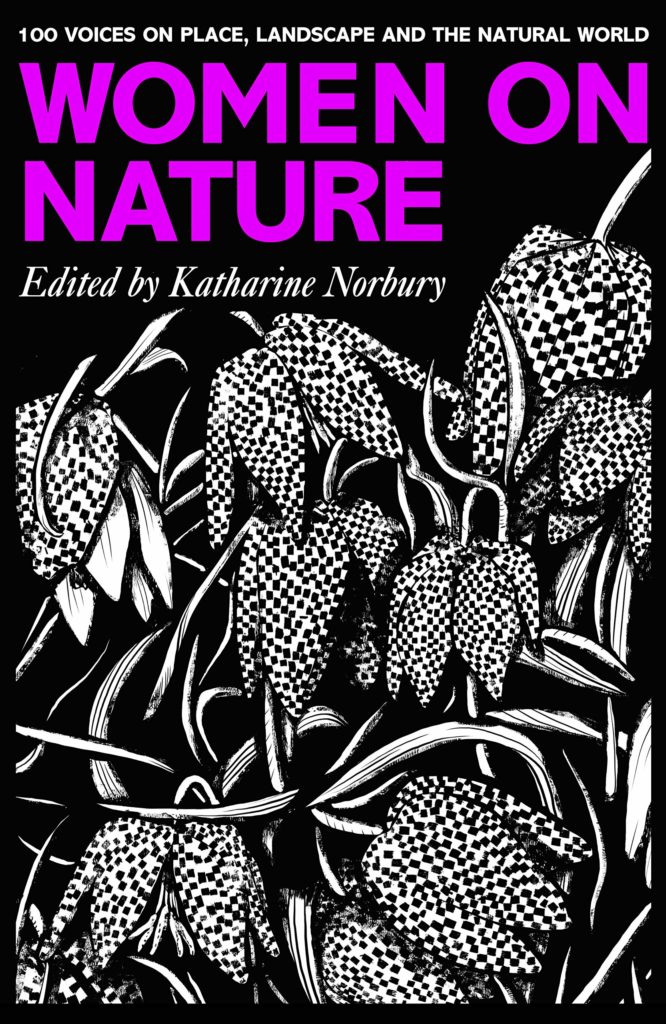‘Women on Nature’ — an anthology of the work of women, over the centuries and up to the present day, who have written about the natural world in Britain, Ireland and the outlying islands of our archipelago — is edited by Katharine Norbury, and just-published by Unbound. Katherine Venn reviews.

Bloody hell, I needed to read this book. I know that sounds dramatic, but I needed it the way you don’t realise how thirsty you’ve been until the end of the day when you’re brushing your teeth, and all of a sudden you’re gulping down handfuls of water and loving it. Reading Women on Nature was 450-plus pages of gulping down handfuls of water.
I try to pay attention to the gender split of what I read, ever since something inside me snapped a few years back and I vowed to only listen to women for a year — by which I mean books written by women, music written by women, films directed by women — just because I was so fed up of the default. Doing an audit of the previous years’ reading, I was pretty shocked to realise that, feminist though I was, I read many, many more books by men than women. It’s almost impossible not to unless you’re paying attention. I pay attention these days.
And as Women on Nature’s editor Katharine Norbury says in her introduction, ‘until really very recently, in our east Atlantic archipelago at any rate, it is true that what we think of as nature writing has been associated almost exclusively with men.’ Just look at what a date once called ‘the Robert Macfarlane table’ at the front of every Waterstones. Yes, women are published, and reviewed, and read. But as with most other spheres, in much smaller numbers. There are historical reasons for this, of course, as Norbury points out: nature writing has often been conflated with travel writing, and it’s been men who have had the time and resources to both travel and write. But even now it’s important to remember that women so frequently feel unsafe going off the beaten track, and for good reason: in the days after Sarah Everard’s abduction and murder this spring, a poet I know shared on Twitter that she’s never felt able to explore the wilds as she’d like, ever since she was chased, in a wood, by a man wearing a hockey mask.
So ‘what would happen, I wondered,’ writes Norbury, ‘if I simply missed out the 50 per cent of the population whose voices have been credited with shaping this particular cultural form? If I coppiced the woodland and allowed the light to shine down to the forest floor and illuminate countless saplings now that a gap has opened in the canopy?’
This gorgeous doorstop of a book is what’s happened, an anthology of over a hundred women writing on that most obvious yet elusive of subjects, nature. Its sheer scope is dazzling, ranging from Dartmoor to the Faroe Islands and the Aran Islands to Essex; from the fourteenth century to the present day; from ‘essay, fiction, journal, letter, life writing, poetry, recipe book to travelogue’. The subjects each writer is concerned with are equally kaleidoscopic: we have a recipe and foraging instructions; linguistic tussles over wildflowers; a falcon’s eyesight; the rewriting of a psalm. This last — by Mary Sidney — captures two things I particularly appreciated about Women on Nature: its inclusion of religious voices and writing (Julian of Norwich, Margery Kempe and Evelyn Underhill, along with some more unfamiliar names), and its historical depth. You could be forgiven for thinking, wandering round a bookshop, that writing on the natural world was invented in the late twentieth century.
This scope and depth is underscored gorgeously by Norbury’s decision to order Women on Nature not by chronology, geography or theme, but alphabetically. (We have an Irish Tree Alphabet, too.) I couldn’t help but think of Hughes and Heaney’s The Rattle Bag, and the effect is the same: a playful telescoping of time and place and subject. It also leads to the happy accident that the book ends with an extract from Dorothy Wordsworth’s walking journal, surely one of those ‘countless saplings’ who deserves to have a bit more of the light her brother absorbs. Similarly, who could not be delighted by seven-year-old Bláthnaid McAnulty’s inclusion, younger sister of 2020’s pandemic nature-writing smash-hit Dara?
I climb up a giant snake when I’m in a tree. I fight dragons when I’m in a tree. I ride a unicorn when I’m in a tree. I’m an adventurous explorer when I’m in a tree. I’ve actually discovered a new species in a tree, but shush don’t tell anyone. I’m saving them for when I’m older and a real life insect expert […] To feel moss, lichen and the bark is like feeling my own heart beat. If I could melt into the tree to find out its secrets, I would.
New voices alongside the well-known and the neglected…Katharine Norbury has done an impeccable job and a huge service to anyone wanting to stroll off the beaten track; not just in collecting these writers together but in encouraging further exploration, with the biographies at the back a helpful signpost. I hope every name at the back of the book who crowdfunded it into being is as delighted with — and awed by — Women on Nature as I am.
*
After having its initial run crowdfunded, ‘Women on Nature’ is available to buy as a wider release. Buy a copy here (£25.00).